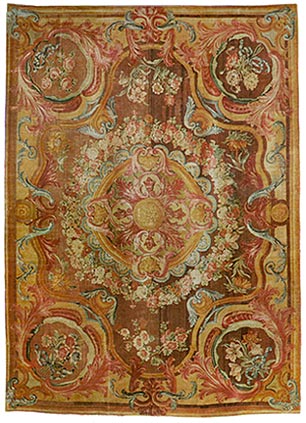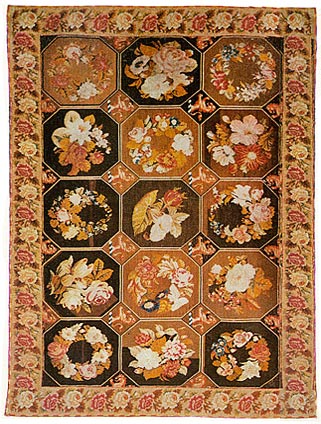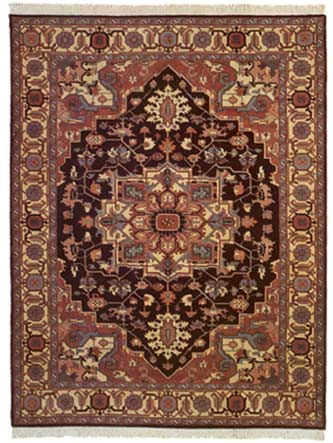RUG GUIDE
Rug Introduction 
The Illustrated Rug 
From Sheep To Rug 
Rug & Knot Types 
Rug Loom Types 
Basic Rug Care 
Stain Removal Guide 
Decorating Ideas 
Purchasing Guide 
Rug Names & Places 
Rug History Chart 
Glossary of Terms 
Presented by NEJAD RUGS:
THE ILLUSTRATED RUG - PART 3FRANCE Following the eighth century conquest of Spain and invasion of France by the Moors, and their subsequent defeat and expulsion, some of these refugees settled in southern France - near Aubusson and the Creuse river - where the water was very conducive to the dying of textiles, as was the climate to the weaving of textiles. Many of them built looms and became weavers, teaching the French natives the art. The earliest French weavings were tapestries in a small all-over pattern design. The occupation of rug and tapestry weaving had begun, and by the thirteenth century French woven products had improved considerably. During the next two hundred years, the art of tapestry spread north and Paris became an important city in the weaving industry - and by the sixteenth century Aubusson tapestries were of an exquisite quality and highly regarded - as evidenced by the demand of the French nobility and the Court at Versailles. The term Aubusson, as well as Savonnerie, itself has become virtually synonymous with the art and craft of French carpet and tapestry weaving.
Aubusson refers to the flat, or tapestry weave of France (can be a wall hanging or a carpet), and customarily has no fringes - the sides hemmed, while Savonnerie refers to a customarily hand knotted pile canvas. The Savonnerie carpets were reserved almost exclusively to the court and the royal family, while the weavers at Aubusson (and manufacturers of this style) made rugs particularly well suited to the public market place - the flat tapestry weave was quicker to work and required much less wool than the knotted pile allowing for faster production and lower price. From the first, textile production was virtually controlled by the crown - the pile rugs were in such demand that production was relocated from the Louvre and into an abandoned soap factory - or Savonnerie. King Henry II, expanded the weaving industry and established production facilities at Paris, Tours, and Felletin. Henry IV established an official state factory in Paris to create the many wall hangings required for his chateau. Louis XIV ordered ninety carpets - some 16' × 30' —for the Palace at Versailles. The grandeur as well as the history built into this golden age of French weaving has perhaps never been, and never will be, equalled. ENGLAND Although England could be considered a relatively late arrival to the field of rug and carpet manufacturing, her contribution was, with regards to both distinctive design as well as far-reaching influence on production methods, no less significant. The hallmark of the English carpet making is the simultaneous development of its own indigenous carpet industry, represented by hand woven rugs featuring the distinctive naturalistic floral design that could be considered "typically British", as well as the mass production of Oriental rugs employing modern methods in a factory setting. The growth of English merchant fleet in the early sixteenth century combined with the accessibilily of mideastem ports encouraged the introduction and importation of the Oriental rug into England. Simultaneously occured the beginnings of a national carpet making industry, featuring hand-knotted rugs and embroideries usually employing a flower (roses, columbines, lilies, tulips, daisies, poppies, cornflowers) or garden related (blooms, butterflies, caterpillars, etc.) theme.
By the eighteenth century fine carpets were being produced at many weaving centers throughout England, catering to a built-in market of royals as well as a large liesure class. The terms Axminster and Wilton (Axminster is the city where Thomas Whitty set up a carpet production facility, subsequently merging with a factory at Wilton), still prevalent today, originate with this era, moreover Axminster has become the definitive term used to refer to English pile carpets. The great industrial advances of the eighteenth century included the following 3 components - each essential in the development of the power loom in England - their combined influence on the carpet weaving industry as such is profound:
By the nineteenth century the British power-driven loom was turning out carpeting by the yard in such quantity, and at such affordable cost, that most homes in England, as a buffer against the wet and often chilly climate, could now be carpeted - but at the expense of the popularity of the hand-knotted rug. Despite this development, the hand woven products have regained a foothold in the marketplace due to higher quality in methods, materials and appearance. English pile carpets were woven predominantly using the Turkish knot, and English needlepoint carpets using the still popular cross-stich method. Green is used liberally in both the pattern and field in all English rugs - ground colors can range from dark brown and black. English design is typified by all types of flowers and flower patterns (most often portrayed in shaded tones of white, ivory, gold and blue green) that span the following periods:
AMERICA The development of the art of hand hooked rug making in Early America can be considered America's contribution to rugmaking. Originally brought to the colonies by early English settlers, this distinctive technique flourished on the northeastern shores of America, from the area of New England to southeastern Canada. Owing to Yankee ingenuity, in the developing of ways and means to conserve and re-use raw materials, while serving the needs and the interests of both frugality and utility, the art of rug hooking (or hand-hooked rugs) became something on the order of a cottage industry in colonial America. The technique involved pulling / pushing pre-cut wool strips (either recycled wool or yarn), through a backing material (linen, cotton, or burlap) which was stretched over a wooden frame - the design sketched in ink or charcoal. A metal hook (often a modified nail) was used to draw the woolen strips through the backing to form loops that were raised approx. ½" from the backing and generally left uncut.
Portraying historic events as well as patriotic American emblems and slogans, or simple geometric forms in primary colors — reds, blues, greens, blacks, whites, rich browns and grays - these rugs often took on a quilted or patchwork effect, and the cloth was dyed using berries, grapes, tree barks, roots, and other natural substances. Other design elements employed included flowers and floral patterns (native New England flowers— lilies, pansies, daisies, roses), single leaves and buds, sprigs, bouquets in baskets, wreaths, medallions, and/or borders, either alone or intertwined, with scroll and vine, as well as nautical themes such as ships, anchors, waves, and stars etc. The art became a popular pasttime among women who hooked rugs for both their decorative appeal and comfort, as well as sailors who had discovered a worthwhile pursuit to keep them busy while at sea for extended periods. Owing to their charm and rustic appeal, as well as versatilty and affordability, the hook rug continues to be a popular item in today's competetive rug market. RUMANIA Since the Middle Ages, when Rumanian weavers learned the craft of carpet weaving from their Ottoman rulers, Rumania has regularly produced carpets for export. Production was limited until after World War II when government-sponsored weaving centers, or cooperatives, were established. At that time, significant efforts were launched to reproduce Persian designs, particularly Tabriz-inspired patterns. Since then, Rumanian manufacturers have been most successful in developing new qualities and designs to meet Western decorative tastes. Weaving in Rumania is performed exclusively by women and is a closely supervised government enterprise. The wool used in their carpets, although coarse, is resilient and lustrous. The predominant quality of carpet produced today is the Bucuresti quality. The weave is approximately 70 knots per square inch and is woven with an all-wool pile on cotton warps and wefts. Four other qualities, Braila, Mures, Olt, and Milcov are also produced with knot counts that range from 70 to about 194 knots per square inch. Traditionally, most designs have been inspired by Persian patterns. Most popular in the Bucuresti quality are Persian designs such as Herizes, Kashans, and Sarouks executed in traditional colors and in a broad range of fashion colors. Sizes range from small scatters to over-sized and custom-sized rugs, with runners up to 30 feet long. In addition, a more limited selection of non-Persian designs has widened the realm of decorative choices available in Bucuresti and other qualities. Among these are antique-style reproductions of Caucasian and European rugs such as the floral French Savonnerie.
Equally important are Rumanian kilims which are part of a rich folk art tradition. Their best historic examples are treasured museum pieces. Rumanian weavers today continue to use traditional flat-weaving techniques to execute the very characteristic curvilinear floral designs. These often incorporate geometric motifs and display a wide range of decorative colorations. Rumania offers a tremendous production potential mainly due to its talented and well-trained weavers and to its high quality control standards. Thanks to the weavers' adeptness at executing a variety of design types in both pile and kilim rugs, today's buyers have a realm of decorative choices at their fingertips. Österreichisches Museum für angewandte Kunst, Vienna |
Whatever it's inspiration, experts consider this Mamluk medallion carpet, woven in Cairo of finely-knotted silk in luminescent and shimmering colors, a supreme achievement of the art of Oriental rugmaking - and one of the world's finest carpets, and certainly one of a kind. -->
The Illustrated Rug - Part 1 | The Illustrated Rug - Part 2 | Rugs of Afghanistan




